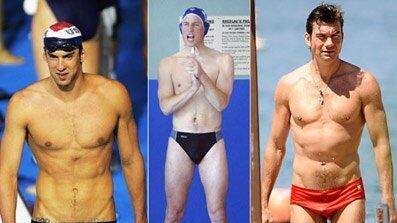At its annual meeting this month in Chicago, the governing body of American competitive swimming voted overwhelmingly to ban full-body swimsuits. This means that after October 1, male swimmers can only wear bathing suits that don’t extend above the navel or below the knees.
What a pity that the USA Swimming delegates didn’t put forth a corresponding motion to prohibit offensively small bathing suits. I’m talking specifically about the rogue cousin of the skimpy swimwear family—the Speedo.

These unrepentantly tight Lycra briefs occupy a unique niche in the pantheon of Too Much Information couture, simultaneously ridiculous and scary. If they were any smaller they’d be a thong—and safely camp. If they were any bigger, they’d be reassuringly sensible like Superman’s overpants. They don’t need a wardrobe malfunction to cause an uproar. They are a wardrobe malfunction.
When I told friends I was doing field research for “Speedo: The Case Against,” most of them inquired, “When is there ever a case for?” Well, to be fair, Olympic swimmers and ocean lifeguards can legitimately claim minuscule swimwear helps them go faster. And few complain when offensively small briefs are worn by hot male models. But out in the real world, I think we can all agree that Speedo-wearing, like skydiving or brain surgery, should really be left to the professionals.
Is there anything more unnerving than an out-of-shape male sporting swimwear with an agenda? Who is it that tells these people it’s OK to wear tinted Saran Wrap? Who is the best friend of every fat guy with a tan, who says, “The teal nut-sling really takes it to a whole new level"?
I once owned a Speedo, when I was 14. Maybe I was little older, but no more than 16. I was on the swim team, which is some excuse. But the color was grape, for which there is no excuse. Where was the parental supervision? Where was guidance? The result of my youthful folly has been a lifelong penance, but also an appalled fascination. At times, the Speedo feels like a Samuel Beckett play. Not fun to watch, but a begrudging respect endures for the severe purity.
The issue only gets more complicated when you take a more global view. In Europe, for example, the Speedo is not just ubiquitous, it’s compulsory. Board shorts are banned in French public pools for “hygienic reasons.” On the Riviera, skimpy briefs are not only standard-issue, they have a totally unironic talismanic status. Apparently, merely wearing a pair, regardless of how old or unfit you are, makes you instantly and attractively macho.
In Britain, there have been recent efforts to contain Euro-pouch fever. This summer, the Alton Towers vacation resort issued an injunction against swimwear that it deemed to be “more suited to Spain than Staffordshire.” A spokesperson said, “We feel this small brief style is not appropriate for a family venue.”
The ban was a tabloid sensation. “The battle of the bulge,” roared The Sun. “Busted for Speedoing!” Radio talk shows debated the story hotly. Shock jock Johnny Vaughan called it “an affront to civil liberties,” saying, “It’s every man’s right to bear, not wear, Speedos.”
Who is it that tells these people it’s OK to wear tinted Saran Wrap? Who is the best friend of every fat guy with a tan who says, “The teal nut-sling really takes it to a whole new level?”
Such joking, as any good Freudian knows, simply indicates a deep-rooted anxiety. But it is an anxiety dealt with nationally in the best vaudeville tradition: by turning the fear-object into an over-the-top villain. Thus, the Speedo in England is the Omarosa of swimwear—the baddie you love to hate. As much as the Brits deride them, if Speedos were comprehensively banned, the country would miss them sorely, too.
The solution to Speedo-anxiety in America is also comedic, but it’s the comedy of unadulterated social terror. In sitcoms and movies, the Speedo is now the go-to signifier for any libidinous narcissist who has no respect for personal space. Russell Brand’s rock star in Forgetting Sarah Marshall, the scuba instructor in Along Came Polly, the yoga teacher in the upcoming Couples Retreat—all are serial Speedo offenders. In the 2005 movie Revolver, Ray Liotta’s hubristic Mafia boss sports a black Speedo while indulging a solarium tan obsession.
By this logic, Australia, where the Speedo was invented, should be purging its national guilt by putting every arch-nemesis and supervillain in cripplingly tight swimwear. But the reality is the complete opposite. Australians have embraced the “great Aussie cossie” and made it a national treasure. Far from being a sign of male peacock delusion, the Speedo Down Under is the symbol of down-to-earth heterosexual masculinity, as evidenced by its nicknames: budgie smugglers, or budgies, or smugglers. A spoof commercial for MTV Australia portrays blue-collar Speedo-clad men as an emergent minority asking the world for tolerance. “There’s a lot of us out there, smuggling,” says a truck driver wearing only a Speedo and work boots. “It’s a pretty standard thing.”
Peter Travis, the Sydney fashion student who invented the Speedo back in 1951, now designs ceramics. He told OutUK Magazine a few years ago that he ascribes the success of his work to “the Wow Factor—when all the elements of a design relate to each other in such a way that it gives a visual impression that is irresistible.” As for his career-launching three-inch briefs, Travis said he created them for “18- to 26-year-olds.”
Not, I repeat, not balding Casanovas or aging swingers or thigh-chafing tubs of lard. Swimming authorities and governing bodies, please take note.






